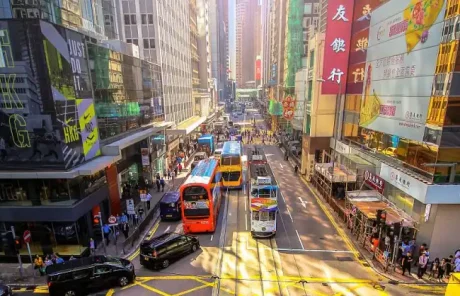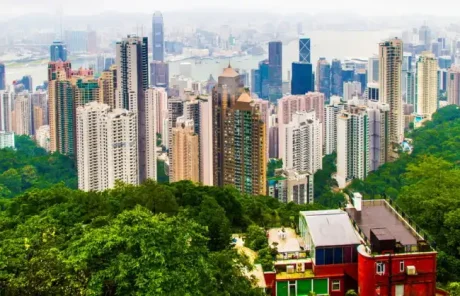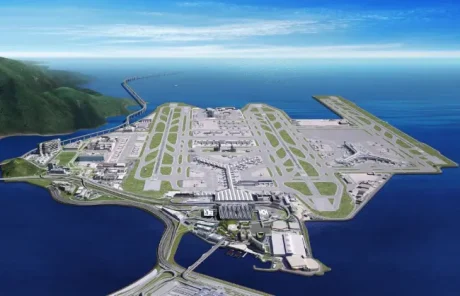Hong Kong Travel Guide: An Ultimate Guide with All Things to Know
A special administrative region of China, Hong Kong is one of the most exciting travel destinations in the world and is famous for abundant things. It is a vibrant international metropolis with East and West cultures coexisting. For shoppers, it is a shopping paradise offering a wide range of world-class malls, and shopping centers. Food lovers are always captivated by the diverse array of global cuisines here. Beyond its modern skyscrapers, bustling street life, stunning Victoria Harbour, and dazzling night scene, hides the charming countryside, tranquil islands, beautiful temples, and plenty of coastlines and beaches.
Hong Kong is located in the central part of the South China coast. It lies to the east of the Pearl River estuary, bordering Shenzhen to the north, faces Macau across the Pearl River estuary, and is adjacent to Zhuhai City in Guangdong Province to the North. This significant geographic location makes it the largest free port in the Far East, and results in its extremely busy harbor scenes.
If you are planning a visit, read our ultimate Hong Kong Travel Guide to get the best travel tips and suggestions for things to do, what to eat, the best time to visit, how to get around, etc.

- Official name: Hong Kong Special Administrative Region of the People’s Republic of China
- Location: On the southern coast of China, bordered by Guangdong Province, Macau, and the South China Sea.
- Currency: Hong Kong dollar (HKD)
- Area: About 1106.66 km²
- Population: 7,531,800 (2024)
- Language: Cantonese, English
Fast Facts about Hong Kong
- Official name: Hong Kong Special Administrative Region of the People’s Republic of China
- Location: On the southern coast of China, bordered by Guangdong Province to the north, the Pearl River estuary and Macau to the west, and the South China Sea to the south.
- Currency: Hong Kong dollar (HKD), exchange rate is about 7.8 HKD to 1 USD
- Area: About 1106.66 km²
- Population: 7,531,800 (2024)
- Language: Cantonese, English
- Religion: Main religions include Buddhism, Taoism, Christianity, and Islam
- Electricity: 220V, 50Hz (UK plug)
- Time zone: UTC+8
- Climate: Maritime Subtropical Monsoon Climate
- Main areas: Hong Kong Island, Kowloon, New Territories (including 260 outlying islands)
Major Regions & Highlights of Hong Kong
Hong Kong can be divided into three geographical regions: Hong Kong Island, Kowloon, and New Territories (including 260 outlying islands). These three regions are further divided into 18 administrative districts, each offering unique charm and attractions.
Hong Kong Island
4 Districts: Central and Western District, Wan Chai District, Eastern District, and Southern District
Hong Kong Island is the earliest developed area in Hong Kong, serving as its commercial and political heart. It is where many luxury commercial buildings, shopping centers, and the Hong Kong Special Administrative Region government are located. Generally, this region is characterized by towering skyscrapers and rich historical sites. Victoria Peak, the highest peak here, offers a spectacular panorama of Victoria Harbor and the cityscape. Causeway Bay and Tsim Sha Tsui are the top shopping areas here. Repulse Bay and Stanley Bay entertain visitors with beautiful beaches.
Kowloon Peninsula
5 districts: Kowloon City District, Kwun Tong District, Sham Shui Po District, Wong Tai Sin District, and Yau Tsim Mong District.
Lying opposite Hong Kong Island, the Kowloon Peninsula is a key gateway connecting Hong Kong to the world and mainland China. It is home to many MTR stations, major train stations, and bus terminals, making it a key transportation hub connecting various districts of Hong Kong Island, New Territories, and mainland China.
As one of the busiest commercial and residential areas, it is home to Mong Kok, Tsim Sha Tsui, Yau Ma Tei, and Jordan which offer various shopping, dining, and entertainment options, and rich traditional culture. If you travel to Hong Kong for its traditional urban atmosphere and life scene, Kowloon is a can’t-miss.
New Territories
9 districts: Islands District, Kwai Tsing District, North District, Sai Kung District, Sha Tin District, Tai Po District, Tsuen Wan District, Tuen Mun District, and Yuen Long District.
Covering the largest part of Hong Kong, the New Territories encompasses central, eastern, northeastern, and southwestern areas and outlying islands. It features diverse terrain and is rich in natural landscapes and sandy beaches, including Lantau Island and Sai Kung, Cheung Chau and Lamma. It has lofty mountains to hike. The many remote villages in this region offer a glimpse into traditional architecture and life. Hong Kong International Airport is also in the New Territories.
Top Attractions & Places to Visit in Hong Kong
You will never run out of things to see and do when traveling to Hong Kong. You could spend multiple days exploring its beautiful temples, bustling streets, busy harbors, towering buildings, etc.
Hong Kong Disneyland
It is the first Disneyland in China, located on Lantau Island. The park combines classic Disney fairy tales with local cultural elements, offering great experiences for families with kids.
Hong Kong History Museum
One of the most important museums in the region, the history museum provides visitors with a window to look into HongKong's history and development from prehistoric times to the present day.
Victoria Harbour
One of the busiest and most beautiful harbors in the world, Victoria Harbour is a landmark of Hong Kong and also the key reason for its economic prosperity. The night view here is especially breathtaking, ranking among the top three nightscapes in the world.
Lan Kwai Fong
Lan Kwai Fong is the symbol of Hong Kong's vibrant nightlife, located in the very heart of Central. It offers diverse fine dining options and open-air bars.
Space Museum
Space Museum is a gateway for kids to dive into the cosmos and space science, located on the Tsim Sha Tsui waterfront. It planetarium has a 23-meter diameter hemispherical screen.
Nan Lian Garden
This classical garden adheres to the garden layout and architectural principles of the Tang Dynasty. Most of its buildings are traditional wooden structures without nails.
Top things to do in Hong Kong
Besides the iconic attractions, the following essential activities will offer you a more in-depth and immersive experience of local culture and life.
Ride the Peak Tram
This 8-minute ride allows a convenient transfer between Central and Victoria Peak. The tramway was originally built as a transportation mode for residents of the peak. Now, as an essential experience when traveling to Hong Kong, the Peak Tram offers visitors great views of the skyline, Victoria Harbour, and surrounding luxurious residential areas during the journey. After reaching the Peak, a more stunning 360-degree panoramic view of the city is waiting for you at the Peak Tower.
Take the Star Ferry
An important means of transportation connecting Hong Kong Island and the Kowloon peninsula, the Star Ferry offers visitors a close-up view of the Victoria Harbour. It has been recognized by National Geographic Travelers as one of the “50 Places of a Lifetime”, with a history of over 130 years. The two main routes of the ferry are Tsim Sha Tsui to/from Central, and Tsim Sha Tsui to/from Wan Chai. A single trip takes about 10-20 HKD.
Ride Ngong Ping 360 cable car
Put Ngong Ping 360 cable car on your list if you plan to visit Lantau Island. This world-class cable car system offers standard and crystal cabins. It’s highly recommended to challenge the crystal cabin with a transparent floor, so you can enjoy a 360-degree view of the island, and the surrounding sea views, airport, and Hong Kong-Zhuhai-Macao Bridge. A sing-way trip takes about 25 minutes.
Hong Kong Tours including Lantau Island:
Visit the Street Markets
Not only offering a wide array of goods, the streets and markets of Hong Kong are also where its vibrancy and livelihood are going on. Just leisurely wander around, you will take in all its smells, noise, and rich colors. Get a first-hand experience of local life and culture in the 10 best Hong Kong Markets.
Stroll along the Tsim Sha Tsui Waterfront
Tsim Sha Tsui Ferry Pier offers an excellent point for admiring the grandeur of Victoria Harbour and the surrounding skyline. From the pier, a leisurely stroll will take you through the Avenue of Stars, Star Ferry, Clock Tower, Kowloon Park, and Harbour City (the largest shopping mall in the city).
Enjoy the Nightlife
Hong Kong’s nightlife is filled with endless fun. From the bustling night markets, and diverse food to the dazzling night views and vibrant bars, everyone can enjoy themselves with the diverse nightlife. Victoria Harbour and the Peak are top spots for night views. Temple Street Night Market and Yau Ma Tei Fruit Market offer unique street scenes at night. Food lovers can head to Temple Street to seek late-night snacks. To enjoy drinks, music, and a lively club scene, Lan Kwai Fong with numerous mid-to-high-end bars and restaurants is always the top choice.
Take Central to Mid-Levels Escalator
This escalator system ranks as the world’s longest outdoor covered escalator system, with a total length of 800 meters and a vertical rise of 135 meters. Its 20 single-direction escalators and 3 moving walkways allow people to transfer from the Central business district to the Mid-Levels residential area in about 20 minutes. Visitors can stop at certain attractions or enjoy food along the way. The escalator is adjacent to many historical sites, such as Central Police Station, and SOHO District.
Go Shopping
Being widely hailed as a shopping paradise in Asia, and even the world, Hong Kong never lacks of shopping opportunities. Central and Tsim Sha Tsui are the concentrated areas of some of the largest and high-end malls, and offer more luxury brand boutiques and large pharmacies. Sham Shui Po is the area for electronics. Causeway Bay is home to many high-end department stores and mid-to-high-end brands. If you’re interested in local-featured handicrafts, Man Mo Temple Market and Jade Market in Yao Mai Tei are great choices.
Related reading: Top 10 Things to Do in Hong Kong with Kids

Hong Kong Food: Where & What to Eat
Top Dishes and Street Food
- Cart noodles: Features rich and flavorful broth which is simmered with shrimp shells and bones. Diners can customize the topping, like bean sprouts, chives, tofu skin, beef or fish balls.
- Dim Sum: Dim Sum is not a certain food but a variety of bite-sized delicacies. It is a hallmark of Cantonese morning tea culture. Some classic dim sum dishes include chicken feet, shrimp dumplings, shumai, char siu bao, etc.
- Fish balls: Made from fresh fish meat and sweet potato starch.
- Put Chai Ko (Steamed Rice Pudding): Made by steaming glutinous rice flour, dried shrimp, and sausage into puddings.
- Typhoon Shelter Fried Crab: A traditional dish originating from local fishing villages. It is made by stir-frying crabs with minced garlic, chili, and fermented black beans.
- Secret Sauce Char Siu (Barbecued Pork): Made by marinating the lean pork and then roasting it to a glossy and enticing red color. Features a sweet and savory taste.
- Pan-Fried Stuffed Three Treasures: Stuff the minced meat or other fillings to tofu, eggplant, and bell peppers, then pan-fry them to golden and crispy.
Best Hong Kong Food Tours:
2 Days Hong Kong Food Tour That You Can’t Miss
Places with Lots of Street Food in Hong Kong
Below are recommended restaurants and eateries in different districts for you to eat like a local. You can download the OpenRice app to check local reviews for each restaurant.
- Sham Shui Po: Hop Yik Tai, Kung Wo Beancurd Factory, Sun Heung Yuen (Kin Kee), Man Kee Cart Noodle
- Prince Edward: Wah Kee Teochew Braised Cart Noodles, Mr Tin HK Cuisine, Kam Fung Restaurant, Kam Wah Cafe
- Mong Kok: Best Nine Beef Brisket, Fei Jie SnackShop, Silk. MongKok
- Yau Ma Tei: Fai Kee Cart Noodles, Tung Tat Food Shop, Temple Street Snacks, Skewer King, pm
- Jordan: Kai Kai Dessert, Cardona Bakery, Mak Man Kee Noodle Shop, Australia Dairy Company
- Tsim Sha Tsui: Bakehouse TST, Hua Xiang Yuan, Red Tea Cafe, Hua Sao Ice Room
- Central: Vission Bakery, Sing Heung Yuen, ChaTraMue, Kwai Tsz Kee
- Wan Chai: Biu Kee Wonton Noodles, Samsen Thai Restaurant, Cheung Fun King, Victoria Harbour Ice Room
- Causeway Bay: Wing Kee Noodles, Danish Bakery
- Tin Hau: Bing Kee Tea Stall, Yue Hing Noodles and Tea Restaurant, Wah Jie Clear Broth Beef Brisket
Where to Stay: Hotels in Hong Kong
Generally, Causeway Bay, Central, Wan Chai, and Tsim Sha Tsui are close to the city center. These districts offer convenience and easy access to major attractions and shopping malls but usually are more expensive for accommodation.
Accommodations in the further Yau Ma Tei, North Point, Jordan, and Tin Hau are more cost-effective and offer a more immersive local culture experience.
If you arrive in Hong Kong late or plan to visit Disneyland the next day, it is recommended to stay overnight near the airport or in the Lantau Island area.
Luxury accommodation recommendations: mostly are along Victoria Harbour
- The Ritz-Carlton: in Yau Tsim Mong District; offers luxurious rooms with stunning views of Victoria Harbour; features two Michelin-starred restaurants.
- The Landmark Mandarin Oriental: in Central, near Central MTR Station; near to Victoria Harbour and the Peak; features two Michelin-starred restaurants and its spa.
- Four Seasons Hotel: Central and Western District; with direct access to IFC mall and offers stunning sea views; features 3 Michelin-starred restaurants.
- Rosewood: In Tsim Sha Tsui, near East Tsim Sha Tsui and Tsim Sha Tsui MTR stations; Features stunning harbor views and an infinity pool seamlessly connected to Victoria Harbour.
- The St. Regis: In Wan Chai District; Offers spacious family-friendly rooms; Features three Michelin-starred restaurants.
- The Upper House: in the Central District; offers stunning sea views; known for its unique design and spacious rooms.
Hong Kong Weather & Best Time to Visit Hong Kong
The best time to visit Hong Kong is from November to March. During this period, the weather is generally pleasant. And even the winter temperatures remain mild.
Starting around April, the weather has a sudden rise, with the averages exceeding 26°C. This marks the hot summer season of HongKong. However, most indoor public places are air-conditioned, ensuring a generally comfortable stay.
Typhoons may occur from May to November according to historical records. Thus, if you plan to visit during this period, pay attention to the latest weather forecasts.
For shoppers, the discount seasons are from July to September, and from Christmas and New Year period to February of the following year.
How to Travel Around HongKong?
Traveling around Hong Kong is convenient thanks to its wide range of public transportation options. The most used modes of transport include the MTR (subway), buses, ferries, trams (Ding Ding), and taxis.
Tips:
- Visitors can download the Google Maps or “HKeMobility” app to search the routes and estimated arrival times.
- Octopus Card is the most commonly used payment card that can be accepted on all public transport and local shops.
MTR (Subway)
- The most convenient option to travel around.
- Visitors can download the “MTR Mobile” app to check routes, fares, and travel times.
- Fare: Varies based on the distance, typically ranging from HK$1.5 to HK$50.
- Payment: Octopus card, Alipay, WeChat Pay, and UnionPay.
Buses
- Mainly operated by KMB and Citybus;
- Can pay by cash and Octopus card, pay upon getting on;
- To alight, please press the stop button to inform the driver.
- Fare: Varies based on distance, about HK$3 to HK$58.
Ding Ding tram:
- Only available on Hong Kong Island;
- Can pay by cash or Octopus card;
- Fare: HK$3 for adults, HK$1.5 for children, and HK$1.3 for seniors;
- Board at the rear and alight at the front.
Taxi
- Three types: Red taxis for urban areas, green taxis for New Territories, and Blue for the Lantau Island area.
- Fares: Starting from HK$22/HK$18.5/HK$17 for the first two kilometers, an addtional HK$1.4-1.6 per 200 meters.
- Ride-hailing Apps: KTaxi, DiDi Hong Kong, Fly Taxi, and Uber
- Payment: Mostly cash, Octopus, and other payment methods are rarely accepted.









